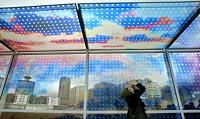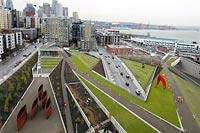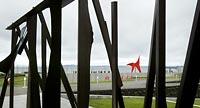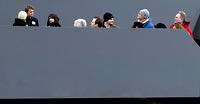|
Friday, June 13, 2008 - Page updated at 12:01 PM Stunning sculpture park could redefine waterfront
It's not often in the life of a city that its identity transforms. Not just the way a place looks or functions, but the way people perceive it, at home and abroad. In Seattle, the last time such a major transition happened was the early 1960s, when the Century 21 Exposition thrust the disk of the Space Needle and the lacy arches of the Pacific Science Center into the urban skyline — and framed them with a new civic gathering place that became Seattle Center. Now the city is poised to receive another image-changing landmark. This Saturday, Seattle Art Museum (SAM) will introduce the Olympic Sculpture Park, a sweeping 9-acre green space at the north end of the downtown waterfront. The park has already captured the attention of city planners in New York and Paris for the innovative way it reunites the city and shore, and it's being hailed as an amazing gift: Most of its $85 million price tag was paid by private donations. One of the park's prime features is its magnificent views. It presents a 360-degree panorama of Puget Sound, the Olympic Mountains, Mount Rainier and the surrounding city. And it makes Seattle a greener place, adding hundreds of trees and thousands of native plants to the urban core. Yet the Olympic Sculpture Park isn't meant to be a simple brush with nature. New York architectural firm Weiss / Manfredi embraced the setting, with all its traffic, trains and busy people. The architects included amenities that city dwellers value, anchoring the park with a sleek pavilion at Western Avenue and Broad Street that houses a cafe, bookshop, exhibition space, restrooms, parking garage, education rooms and high-tech security center. Admission to the park will be free. Coming up Opens to the public Saturday. Opening-weekend events include performances and family activities, 10 a.m.-9 p.m. Saturday and 11 a.m.-6 p.m. Sunday. 2901 Western Ave., Seattle (206-654-3100 or www.seattleartmuseum.org For art-lovers around the country and the world, the Olympic Sculpture Park will be a place of pilgrimage, boasting more than 20 major sculptures by some of the top names in 20th century art: Richard Serra, Alexander Calder, Claes Oldenburg, Mark di Suvero and Louise Nevelson among them. An outdoor amphitheater will host performances, and plenty of open space remains for temporary installations and site-specific projects. For those who prefer more contemporary visions, the park includes newly commissioned artwork on a grand scale: a major fountain designed by revered 95-year-old sculptor Louise Bourgeois; a colorful 200-foot glass bridge canopy by up-and-coming artist Teresita Fernández; a sloped greenhouse encasing a 60-foot nurse log by conceptual artist Mark Dion. To enable future projects, the park is fully wired with power and data connections in addition to water access along the entire 2,500-foot path. That path provides a meandering journey that bridges Elliott Avenue and a set of working railroad tracks to culminate in an alluring 850-foot strip of restored beach. That modest bit of sand and sea grass restores fish habitat and provides a place for urban Homo sapiens to dip their toes in salt water — the only slice of natural shoreline in downtown. Not everybody has been happy about construction of the Olympic Sculpture Park. Waterfront-trolley fans protested the displacement of the vehicle's maintenance barn. Hempfest supporters complained when park construction put a squeeze on access to the adjacent Myrtle Edwards Park during the group's festival last summer. Others have spoken out about the selection of artworks. Just wait a while, says Seattle City Councilman Peter Steinbrueck. Let people see the park for themselves. Sculpture Park Funding Land: $20 million Environmental cleanup: $5 million Construction/infrastructure: $40 million Endowment for park maintenance: $20 million Total: $85 million Public funds Most of the park's costs have been paid for by private donations. The public funding breaks down like this: City: $6 million King County: $1.7 million State: $8.1 million Federal: nearly $5 million Total: nearly $21 million Source: Seattle Art Museum "I expect it will be a real eye-opener. It's going to be an 'aha' moment when that park is open to the public," Steinbrueck said. "Even if you are not into the art, the panorama it provides is just stunning. It does feel like it begins to reconnect us to our place here in Puget Sound — and that's a great thing." New possibilities Seattle has one of the most spectacular natural settings of any city in the world, but all that beauty may have made developers a little careless. Why bother with the downtown waterfront — so important for commerce — when people can escape to Green Lake or go hang out at the arboretum? "Seattle has a long history of a lack of public open space downtown," says Jerry Finrow, dean emeritus of the University of Washington's college of architecture and urban planning, and chair of Seattle's planning commission. "Just about any city of significance in the country has more. Cleveland — not a city Seattle likes to compare itself with — has some of the most remarkable and fantastic urban open space of any U.S. city." Portland, too, he says, is way ahead of the Emerald City. But as civic leaders emphasize the importance of urban density to save the splendor of the surrounding countryside, they also recognize the need for parks and civic spaces downtown. As the Alaskan Way Viaduct debate heats up, some are hoping a walk in the Olympic Sculpture Park will open people's minds to new possibilities for downtown. "I think it will give people a sense of what we can accomplish on the rest of the waterfront if we take care," said Seattle Mayor Greg Nickels. "I think people will see [the park] and they will want more ... this will give them a flavor of what's possible." Nickels pointed to Chicago's Millennium Park as an example of how a city can blossom by providing world-class gardens, performance space, art and plenty of room to breathe in the heavily trafficked core of the city. Seattle's new sculpture park, while much smaller, offers a sample of the amenities this city has been lacking. "That area might have developed very differently, have turned into condo and retail space and not the wide-open panorama it now provides," said Councilman Steinbrueck. "It's next to [Belltown] the state's fastest growing and densest area, denser even than Capitol Hill, and it's going to continue. [The park] will spur new economic development in the area, which will be positive. It brings life to that part of the waterfront ... and sets a whole new tone." Even while the rest of the waterfront is being debated, the Olympic Sculpture Park is making life a little sweeter for some who live downtown, says urban designer and viaduct opponent Cary Moon. "My kids ride the school bus past the park every day. They talk about it every day. They see the eraser rolling down the hill. They see the silver tree, and they think it's fantastic. They think it is beautiful and otherworldly." Building a dream One day in 1995, former Microsoft president Jon Shirley and his wife Mary were looking out the window of their waterfront home in Medina at the growing collection of large-scale outdoor sculptures in their garden. Thinking about their future, the question came up: "Where is all this going to go?" With the idea for a sculpture park in mind, the Shirleys approached Seattle art patron Virginia Wright. She went for it. Wright suggested they get together with Seattle Art Museum director Mimi Gates over lunch and lobby for her support. Later, on a fishing trip in Mongolia, Gates mentioned the idea to her friend Martha Wyckoff, a board member of the Trust for Public Land, and the process of finding a location for the park took off. At the time, neither Gates, nor anyone else involved, had a clue how big their idea would turn out to be. Gates describes her role in the park as a conductor "wielding a baton." As a museum director, she was well aware other institutions around the country would be courting patrons like the Shirleys and the Wrights, hoping to receive their valuable artworks. So Gates jumped on board the sculpture-park plan immediately: "My concern was always to make sure that the great art in Seattle private collections stays here." The initial land purchase by the museum and the Trust For Public Land garnered a rare chunk of downtown waterfront property. It seemed like a dream come true. The dark side was that the site — a defunct Unocal storage facility — was a toxic hazard, drenched in petroleum. Another downfall was that the land was crossed by a busy arterial street and working railroad tracks. SAM hired Chris Rogers from the Trust for Public Land to manage the complicated park project and serve as intermediary with public agencies. Because of the unusual nature of the project, which intersects city roadways and the downtown seawall, and because toxic-waste cleanup and salmon restoration was involved, the park received some $21 million from public agencies. City transportation funds helped pay for seawall stabilization and bridging the railroad tracks. Federal funds went to restore salmon habitat and the state Department of Ecology chipped in to solve the hazardous-waste problems. King County and the city of Seattle helped with a small additional land purchase. The remaining private funds were raised from more than 6,500 donors as part of SAM's $180 million capital campaign, which also includes a major expansion to the downtown museum (opening in May) and repairs at the Seattle Asian Art Museum on Capitol Hill. So far, the museum has raised $173 million. The Shirleys gave $30 million — including a $20 million endowment that ensures long-term maintenance of the park — in addition to their gifts of art. In return, they were offered naming rights. In an unusual move for big-time philanthropists, they didn't use the opportunity to glorify themselves. "Mary and I agonized over it for a long time. We didn't want it to be named after us," Jon Shirley said. Then, one day, while visiting the site, the mountains were out — and that was it. Since they first envisioned it, the Olympic Sculpture Park has become much more than a place to show art, and Shirley is proud of the way it has grown. "I think the impact on the city is going to be huge. I've had people come up to me and say that 50 to 100 years in the future this is going to be one of the things that's remembered of the era. ... It will be a big international draw," Shirley said. "If that's true, and I think it is, then we will have accomplished a really amazing thing. "We didn't really start with great ambitions, but it has come to pass." News researcher Gene Balk contributed to this story. Sheila Farr: sfarr@seattletimes.com ).Copyright © 2007 The Seattle Times Company Most read articles
|
Seattle Times Special
Miracle Machines: The 21st-Century Snake Oil
The Favor Factory
Confronting Malaria
Pike Place Market
Your Courts, Their Secrets
License to Harm
The Bering Sea
Olympic Sculpture Park |














